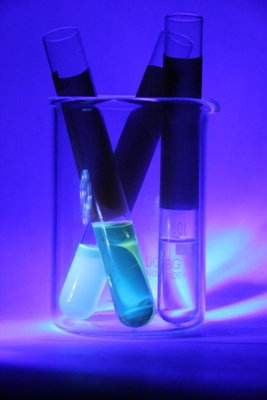Jun 5 2013
It’s not easy going green. For home lighting applications, organic light emitting diodes (OLEDs) hold the promise of being both environmentally friendly and versatile. Though not as efficient as regular light-emitting diodes (LEDs), they offer a wider range of material choices and are more energy efficient than traditional lights. OLEDs can also be applied to flexible surfaces, which may lead to lights or television displays that can be rolled up and stowed in a pocket.
 Novel cadmium selenide (CdSe) quantum dots with ligand enhancement chemistry. The vials on the left contain quantum dots; the vial on the right contains solvent without quantum dots. Credit: Delaina
Novel cadmium selenide (CdSe) quantum dots with ligand enhancement chemistry. The vials on the left contain quantum dots; the vial on the right contains solvent without quantum dots. Credit: Delaina
A promising line of research involves combining the OLEDs with inorganic quantum dots, tiny semiconductor crystals that emit different colors of light depending on their size. These “hybrid” OLEDs, also called quantum dot LEDs (QD-LEDs), increase the efficiency of the light-emitting devices and also increase the range of colors that can be produced. But commercially manufacturing this promising green technology is still difficult and costly.
To make OLEDs more cheaply and easily, researchers from the University of Louisville in Kentucky are developing new materials and production methods using modified quantum dots and inkjet printing. The team will discuss its work developing more commercially feasible QD-LED devices at the Conference on Lasers and Electro-Optics (CLEO: 2013) June 9-14 in San Jose, Calif.
According to Delaina Amos, professor at the University of Louisville and principal investigator of the team’s efforts, expense of materials and manufacturing processes has been a major barrier to using OLEDs in everyday lighting devices.
To inexpensively apply the quantum dots to their hybrid devices, the Louisville researchers use inkjet printing, popular in recent years as a way to spray quantum dots and OLED materials onto a surface with great precision. But unlike other groups experimenting with this method, Amos' team has focused on adapting the inkjet printing technique for use in a commercial setting, in which mass production minimizes expense and translates to affordable off-the-shelf products. "We are currently working at small scale, typically 1 inch by 1 inch for the OLEDs," Amos says. "The process can be scaled up from here, probably to 6 inches by 6 inches and larger."
“There’s a reason you don’t see OLED lights on sale at the hardware store,” says Amos, though she adds that they do find uses in small devices such as cameras, photo frames, and cell phone displays. To bring their QD-LEDs closer to becoming market-ready as household lighting appliances, Amos and her team have been synthesizing new, less expensive and more environmentally friendly quantum dots. The team has also modified the interfaces between the quantum dots and other layers of the OLED to improve the efficiency with which electrons are transferred, allowing them to produce more efficient light in the visible spectrum.
In addition to their higher efficiency, wider range of colors, and ability to be applied to flexible surfaces, Amos' QD-LEDs also use low-toxicity materials, making them potentially better for the environment. “Ultimately we want to have low cost, low toxicity, and the ability to make flexible devices,” Amos says. The team has recently demonstrated small working devices, and Amos adds that she hopes to have larger devices within the next several months.
CLEO: 2013 presentation CF1M.3. “Printed Hybrid Quantum Dot Light-Emitting Diodes For Lighting Applications” by Delaina A. Amos is at 9:15 a.m. on Friday, June 14 in the San Jose Convention Center.